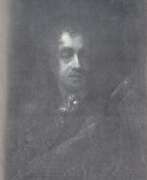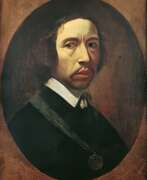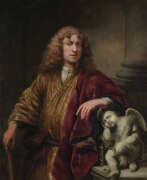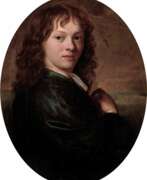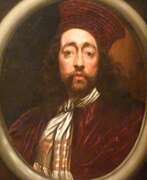Portraitist 17th century


Cristofano Allori was an Italian painter of the late Florentine Mannerist school, painting mostly portraits and religious subjects. Allori received his first lessons in painting from his father, Alessandro Allori, but becoming dissatisfied with the hard anatomical drawing and cold coloring of the latter, he entered the studio of Gregorio Pagani. When still young he became a court portraitist for the Medicis, though many of his commissions were replicas of portraits by his predecessor Bronzino, or had participation by others.[citation needed. His pictures are distinguished by their close adherence to nature and the delicacy and technical perfection of their execution. His most famous work, in his own day and now, is Judith with the Head of Holofernes.


Alessandro Allori, full name Alessandro di Cristofano di Lorenzo del Bronzino Allori, was an Italian painter of the Florentine school of late Mannerism.
Allori was one of the major artists of Florence in the late 16th century. He painted prostrate images and portraits. His son Cristofano Allori (1577-1621) also became an artist.


Antonio Amorosi was an Italian painter of the late Baroque period.
Amorosi studied in Rome in the studio of Giuseppe Ghezzi. He produced portraits and religious works, but he is best known for his genre paintings of bambocanti. The artist has a keen eye for the everyday lives of ordinary people, particularly children, whose world he depicts in a gentle and delicate manner. Among Amorosi's most characteristic and best works are "Boy with a Glass" and "Boy with a Dog", preserved in the Pinacoteca Comunale in Deruta.


Giovanni Andrea Ansaldo was an Italian painter active mainly in Genoa. He trained under Orazio Cambiasi and possibly collaborated with Bernardo Strozzi. Ansaldo's works are typical of the Genoese eclecticism of the early 17th century, influenced by Flemish artists. Ansaldo was responsible for the fresco decoration of the cupola of the Basilica della Santissima Annunziata del Vastato of Genova. His Annunciation fresco is considered the first true Baroque painting in the city.


Francesco Faraone Aquila was an Italian engraver. In 1690 he moved to Rome where his brother Pietro had been an engraver for several decades in major workshops in the capital. Pope Clement XI gave him an order which has remained his main work - engraving the bas-reliefs of the Antoninus Pius column and its pedestal. Another important work by Francesco Aquila is the engraving of the frescoes of the dome of the Cathedral of Parma by Correggio and the painting of the Vatican chambers. Following the antique taste established in the 18th century, Aquila engraved various Roman classical works: statues, vases and triumphal arches, thus satisfying the demand of mainly foreign visitors, mainly German and English. His portraits of his contemporaries, both painters and clergymen, also enjoyed great popularity.


Gioacchino Assereto was a prominent Italian Baroque painter, celebrated for his dramatic and emotionally charged works that often depicted religious and historical subjects. Born in Genoa in 1600, Assereto's early career was marked by his apprenticeship with Luciano Borzone and Giovanni Andrea Ansaldo, which laid the foundation for his development as an artist. His paintings are known for their vibrant light effects and dynamic compositions, a style significantly influenced by Caravaggio during Assereto's brief visit to Rome in 1639. This influence is evident in his masterful use of chiaroscuro and sfumato techniques, which added depth and realism to his works.
Assereto's oeuvre includes powerful pieces like "The Lamentation," notable for its intense shadows and dramatic portrayal of Christ's body, and "The Torture of Prometheus," a work that showcases his later years' shift towards more emotional and theatrical compositions. His "Death of Cato" and "Ecce Homo" further illustrate this evolution, moving from refined styles to bold, expressive techniques that emphasize violent emotions through the dramatic effects of light.
Throughout his career, Assereto's works were highly regarded, with contemporary Genoese biographer Raffaele Soprani praising him as incomparable. His paintings can be found in significant collections, including the Musei di Strada Nuova in Genoa, the Cummer Museum of Art and Gardens, and the National Gallery in London. Assereto's legacy extends beyond his lifetime, with his son Giuseppe Assereto and others producing many copies of his work, ensuring the endurance of his artistic influence.
For art collectors and experts, Assereto's work embodies the Baroque spirit with its emotional intensity and technical mastery. His ability to convey deep psychological tension and his innovative use of lighting make his paintings a valuable study in the evolution of Baroque art.
If you're passionate about Baroque painting and interested in staying updated on sales and auction events related to Gioacchino Assereto's works, consider signing up for updates. This subscription will ensure you're informed about new opportunities to acquire pieces by this master of the Baroque period, enriching your collection with the depth and drama of Assereto's art.


Jacob Adriaensz Backer was a prolific artist of the Dutch Golden Age, known for his dynamic portraits, religious subjects, and mythological scenes. Over a span of twenty years, Backer produced approximately 140 paintings, standing out for his quick execution and attention to detail. His ability to capture intricate details like cuffs, fur, and collars within a short period was renowned, exemplifying the Dutch wet-on-wet painting technique's success during his era.
Influenced by notable figures such as Wybrand de Geest, Peter Paul Rubens, and Abraham Bloemaert, Backer was also celebrated for his drawings of nudes, showcasing his versatile skill set. His works were a testament to the baroque movement, characterized by vivid expression and intricate detail. Notable among his works are portraits that convey the subject's essence with exceptional clarity and depth, earning him a distinguished place among his contemporaries in Amsterdam.
Despite his significant contributions to Dutch art, Backer led a life focused solely on his art, never marrying or purchasing a home, possibly sharing his living quarters with relatives. He was deeply embedded in the artistic milieu of Amsterdam, having been one of the most independent pupils of Rembrandt between 1632 and 1634, absorbing and reflecting the master's style in his works.
For collectors and experts in art and antiques, Jacob Adriaensz Backer's work offers an insight into the Dutch Golden Age's rich cultural and artistic landscape. His legacy continues to be celebrated in major museums and collections worldwide, including the Rijksmuseum in Amsterdam and the National Museum in Warsaw, where his influence on portrait and genre painting remains undisputed.
To stay updated on exhibitions, sales, and auctions related to Jacob Adriaensz Backer, subscribing to newsletters from reputable art galleries and auction houses is advisable. This ensures you receive timely information on opportunities to engage with the works of this masterful Dutch Golden Age painter.


Giuseppe Badaracco also called “Il Sordo” (the Deaf), was an Italian painter of the Baroque period, active mainly in Genoa, in Liguria and in the island of Corsica. He worked for some years in Florence, where he copied many of the works of Andrea del Sarto. Returning to Genoa, he painted mainly for private customers. He worked also in Corsica (at that time part of the Republic of Genoa), where he painted locally influential paintings for some churches around Bastia.


Elias Baeck called "Heldenmuth", was a German painter and engraver from Augsburg. Baeck worked for some time in Rome, then in Laybach, but finally returned to Augsburg, where he died in 1747. His chief works — both in painting and engraving — were portraits and landscapes. His engravings are sometimes signed "E.B.a.H.", standing for "Elias Baeck, alias Heldenmuth".


Ludolf Bakhuizen was a Dutch painter of the 17th and early 18th centuries. He is known as an outstanding master of seascapes. Bakhuizen also painted biblical themes and portraits of his contemporaries as well as engravings and miniature models of ships.
Ludolf Bakhuizen is considered one of the best marine painters of the Golden Age of Dutch painting. Among the admirers of his work were many influential European rulers, including the Russian Tsar Peter the Great. The master met Peter I, who visited Amsterdam in the mid-1690s and, according to contemporaries, even managed to give some painting lessons to the Russian tsar. In addition, Вakhuizen made models of all kinds of ship designs on commission from Peter the Great.
Toward the end of his life, the Amsterdam authorities honored Bakhuizen by opening his own gallery on the top floor of the City Hall for his achievements in the fine arts. The best masterpieces of his work are now preserved in museums in the Netherlands, Germany, England, France, and Italy.


Simone Barabino was an Italian painter of the late-Mannerist style. Born in Val de Polcevera, near Genoa, he was mainly active in his native city, where he trained with Bernardo Castello. Notable works include San Diego restoring sight to blind child for the Nunziata del Guastato in Genoa and Dead Christ with the Virgin and Saints Michael and Andrew for the church of San Girolamo at Milan.


Andrea Bianchi, known as “Vespino”, was a professional painter who worked in Milan. He was the favourite artist of Cardinal Federico Borromeo, who commissioned him to make a number of copies of great Renaissance masterpieces, and of works by Leonardo da Vinci in particular.


Abraham Bloemaert was a Dutch painter, draughtsman, and printmaker from the Golden Age of Dutch painting, one of the founders of the Guild of St. Luke in Utrecht. Bloemart was a caravagist. He painted mainly landscapes, mythological and biblical scenes, and pastoral works.


Cornelis Bloemaert the Younger, a Dutch Golden Age painter and engraver, was born in Utrecht. He studied painting with his father and other prominent artists before focusing primarily on printmaking. Bloemaert traveled to Paris and Rome, where he made engravings of renowned Italian paintings. His engravings were known for their rich colors and smooth transitions. He collaborated with Charles de la Haye on the engraving of Pietro da Cortona's frescoes in the Palazzo Pitti. Bloemaert remained in Rome until his death, having achieved great success in his career. He was a member of the Bentvueghels art group.
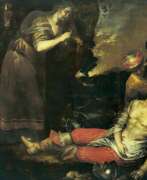

Luciano Borzone was an Italian painter of the late Mannerist and early Baroque periods, working mainly in Genoa. After an apprenticeship with Filippo Bertolotto, his uncle, Duke Alberigo of Massa Lunigiana, patronised his work as a pupil of Cesare Corte.
Luciano Bordzone was an outstanding portrait painter. In Genoa he painted the Purification for the church of San Domenico and the Baptism of Christ for the church of Santo Spirito.




Paul Bril was a prominent Flemish painter, best known for his significant contributions to landscape painting. Born around 1554 in Antwerp, he later moved to Rome, where he became a central figure in the art scene, influencing the Italian and Northern European landscape painting traditions.
Paul Bril's early works were steeped in the Flemish manner, exhibiting a picturesque arrangement of landscape elements with dramatic contrasts of light and dark. His style evolved during his stay in Rome, influenced by the work of Annibale Carracci and Adam Elsheimer. By around 1605, Bril's compositions became more serene and classical, showcasing calmer transitions from foreground to background and embracing pastoral and mythological themes.
Paul Bril's contributions extended beyond his paintings. He was a respected figure in Rome's art community, becoming the first foreign director of the Accademia di San Luca in 1621. His patrons included some of the most influential families in Rome, and his work was sought after by collectors and fellow artists. Bril's influence was profound, impacting future generations of artists, including the Dutch Italianates and genre painters active in Rome.
His works can be found in prestigious galleries worldwide, illustrating his enduring legacy in the art world. For collectors and art and antiques experts, Paul Bril's work represents a significant period in the evolution of landscape painting, blending Flemish traditions with Italian classicism.
For those interested in exploring the captivating landscapes and historical significance of Paul Bril's art, staying informed about new product sales and auction events is essential. Signing up for updates can provide valuable insights and opportunities to acquire pieces associated with this influential artist.


Peter Candid was a Flemish painter, tapestry designer, draughtsman and sculptor.
Pieter Candide worked mainly in Italy and Germany. He was an artist at the court of the Medici in Florence and at the Bavarian court of Duke Wilhelm V and his successor Maximilian I in Munich.
His paintings range from historical paintings, portraits, mythological scenes and allegories. He created large altarpiece images as well as complex decorative designs.
Candide's style was characterised by a combination of Italian and Flemish influences, with a particular emphasis on detailed, realistic depictions of the human form.


Simone Cantarini, an Italian painter and etcher, is renowned for his significant contributions to Baroque art. His early artistic journey was shaped by local naturalism and Venetian influences, notably under Giovanni Giacomo Pandolfi and Claudio Ridolfi. Cantarini's work is distinguished by its blend of Bolognese classicism and a keen naturalism, drawing inspiration from the likes of Federico Barocci, Guido Reni, and Caravaggesque artists like Orazio Gentileschi.
Simone Cantarini's oeuvre spans religious subjects, reflecting the Counter-Reformation's influence, to expressive portraits and dynamic etchings. His art, which shows a fascination with light and color, evolved towards a more personal style over time, moving away from academic classicism to embrace a more naturalistic and lyrical approach.
His works, such as "The Holy Trinity in Glory" and "The Rest on the Flight into Egypt," showcase his ability to infuse traditional themes with a fresh perspective and emotional depth. Simone Cantarini's legacy continues to be celebrated in various collections worldwide, where his masterful blend of classicism and naturalism remains a subject of admiration and study.
For collectors and experts in art and antiques, understanding Cantarini's artistic journey and the distinct qualities of his work offers valuable insights. If you're keen on staying informed about Cantarini's works, exhibitions, and auctions, consider subscribing for updates. This subscription will keep you abreast of new findings and opportunities related to Simone Cantarini's art, enhancing your collection and knowledge in this specialized field.


Bernardino Capitelli was an Italian painter and etcher of the Baroque period. Capitelli achieved the unique position of virtually the only tenebrist etcher in Italy. The use of abrupt contrasts of light and dark is characteristic of Capitelli's work.


Louis Caravaque was a French portrait painter renowned for his contributions to Russian art during the early 18th century. Born in 1684 in Marseilles, France, Caravaque embarked on his artistic journey influenced by his family's background in decorative painting. His talent soon caught the attention of influential figures, leading to a pivotal contract in 1715 that took him to Russia. There, he famously painted Peter the Great and became a favored artist at the Russian court.
Caravaque's work is distinguished by his detailed and expressive portraiture, which earned him the position of the first court painter during Anna Ioannovna's reign. He played a significant role in the cultural exchanges between France and Russia, melding Western European techniques with Russian traditions. His notable works, which include portraits of Russian royalty and nobility, are held in prestigious collections such as the Hermitage and the Russian Museum in St. Petersburg.
Among his most celebrated paintings are the portraits of Peter the Great, Empress Elizabeth as an Olympic goddess, and Catherine II, showcasing his skill in capturing the grandeur and intricacy of his subjects. These artworks not only highlight his mastery of oil painting but also reflect the rich historical and cultural milieu of his time.
For collectors and art experts, the legacy of Louis Caravaque offers a fascinating glimpse into the intersection of French artistic influence and Russian imperial identity. His works remain a testament to his skill and the cultural bridge he helped forge between two distinct worlds.
For more information and to stay updated on exhibitions featuring Louis Caravaque’s work, consider signing up for updates related to this remarkable artist.
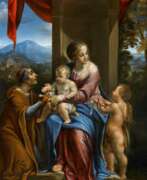

Angelo Caroselli was an Italian painter, born and active during the Baroque period, primarily in Rome. Known for his eclectic style, Caroselli's work was significantly influenced by Caravaggio, evident in the naturalism and chiaroscuro that marked his compositions. His subject matter often included colorful characters from contemporary Rome, scenes of witchcraft, musicians, and genre scenes reflective of the Caravaggisti, a group of artists who followed Caravaggio's stylistic approach. Caroselli's ability to blend allegories, religious works, and portraits with genre scenes showcased his search for originality and a unique narrative voice within the Baroque movement.
Angelo Caroselli's career was marked by his versatility as not only a painter but also an art restorer, copyist, and possibly a forger. This breadth of skills contributed to the diverse body of work he left behind, which ranged from scenes of everyday life to complex allegorical compositions. His works often depicted the lower echelons of society, including musicians, card players, and prostitutes, infused with a potent naturalism that brought these figures to life against the backdrop of 17th-century Rome.
Despite his adherence to Caravaggesque forms and themes, Angelo Caroselli's work also displayed 'archaicising' elements, which some art historians view as a conscious departure from the dominant Baroque style of his time. This aspect of his work, along with his skill in copying the works of ancient masters, highlights a deliberate exploration of and departure from the prevailing artistic norms, contributing to the unique place he occupies in Baroque art history.
Notably, Caroselli's influence extended beyond Italy, affecting the work of other Caravaggisti, including the Lucchese painter Pietro Paolini and the Dutch painter Dirck van Baburen. This cross-cultural impact underscores the broader significance of Caroselli's work within the Baroque period and its enduring influence on subsequent generations of artists.
His legacy includes several known works that are housed in prestigious institutions and collections worldwide, exemplifying the enduring appeal and historical importance of his artistic contributions. Among these, "The Plague at Ashdod (after Poussin)" stands out as a significant piece, reflecting his capability to engage with and reinterpret the works of his contemporaries and predecessors.
For collectors and experts in art and antiques, Caroselli's oeuvre offers a fascinating glimpse into the Baroque period's complexity, characterized by a blend of innovation, tradition, and a deep engagement with the human condition. His work remains a testament to the vibrancy and dynamism of 17th-century Italian art, inviting ongoing exploration and appreciation.
To stay updated on new discoveries, sales, and auction events related to Angelo Caroselli, sign up for our newsletter. This subscription ensures you're the first to know about the latest findings and opportunities to acquire works by or related to Angelo Caroselli, catering specifically to enthusiasts and collectors of historical art and antiques.


Giulio Carpioni was an Italian Baroque painter, etcher, and a significant figure in the early Baroque period, primarily associated with Venice and Vicenza. His artistic journey began under the mentorship of Alessandro Varotari, known as Il Padovanino. Carpioni's work was influenced by various artists and styles, including the realism and objectivity characteristic of Saraceni and Jean Leclerc, as well as Lombard painting, which he encountered during a trip to Bergamo.
Giulio Carpioni's oeuvre includes a mix of religious and mythological subjects, demonstrating a penchant for narrative and allegory, often depicted with a distinctive graphic line and a warm tonal palette. Noteworthy works include the Apotheosis of the Dolfin family and the Allegory of the Grimani Family, showcasing his ability to blend mythological themes with a vibrant expression of Baroque aesthetics.
His bacchanal scenes, such as the one described in a detailed analysis on the Museo Nacional Thyssen-Bornemisza's website, exhibit his skill in composition and use of color to create dynamic, engaging scenes. Giulio Carpioni's influence extended through his etchings and collaborative works, contributing significantly to the art culture of his time.
For collectors and art enthusiasts interested in Carpioni's work, staying informed about exhibitions, sales, and auctions is essential. Signing up for updates can provide access to the latest information on Giulio Carpioni's pieces, ensuring you don't miss out on new discoveries or opportunities to add to your collection.


Annibale Carracci was an Italian painter and instructor, renowned for his influence in the transition from Mannerism to the Baroque style. Born into a humble family in Bologna, Annibale, alongside his brother Agostino and cousin Ludovico, founded the Accademia degli Incamminati, promoting a new artistic approach that combined a thorough study of nature with the study of previous art masters. This approach aimed to form a universal style, distinguishing their work from the mannered art of their contemporaries.
Annibale's work in Rome, especially his frescoes in the Palazzo Farnese, showcased his mastery of illusionistic elements, drawing inspiration from classical antiquity and the works of Michelangelo Buonarroti and Raphael. His work on the Galleria Farnese ceiling is particularly noted for its integration of classical ideals with dynamic Baroque energy, making it a seminal work in the evolution of Baroque art. His style influenced a myriad of artists, including Peter Paul Rubens, Nicolas Poussin, and Gian Lorenzo Bernini, and his approach to painting, emphasizing a blend of idealism with observational naturalism, set a new standard for European art.
Annibale Carracci's legacy extends beyond his frescoes; his genre paintings and landscapes were pivotal in elevating these forms to new prominence. His innovative techniques and thematic versatility have ensured his esteemed place in art history, influencing the trajectory of 17th-century European art.
For art collectors and experts, Annibale Carracci's works represent a pivotal moment in the evolution of European painting, showcasing a transition from the detailed naturalism of the Renaissance to the expressive dynamism of the Baroque. His influence is evident in the works of subsequent generations of artists, marking him as a figure of immense historical and artistic significance.
To stay updated on new product sales and auction events related to Annibale Carracci, consider signing up for our updates. This subscription will provide you with curated information pertinent to the legacy and art of Carracci, ensuring you remain informed about opportunities to engage with his enduring artistic influence.


Alessandro Casolani was an Italian painter of the late-Renaissance period, active mainly in Siena. He was also called Alessandro della Torre. His works are principally in the churches of Siena, but are also found in Naples and Genoa. He also etched one plate, a Madonna. His son, Ilario Casolani was also a painter. Among the pupils of Casolani are Bernardino Capitelli, Sebastiano Folli, and Giovanni Biliverti.


Ilario Casolano was an Italian painter of the Baroque period. He was, like his father, Alessandro Casolano, was a pupil of Cavalière Cristoforo Roncalli. He assisted his father in some of his frescoes, and after his death, finished the fresco of the Assumption of the Virgin. He painted several pictures for the churches in Rome.


Bernardo Castello (or Castelli) was an Italian painter of the late-Mannerist style, active mainly in Genoa and Liguria. He is mainly known as a portrait and historical painter. He was apprenticed under Andrea Semino and Luca Cambiaso, then travelled throughout Italy, meeting other painters and creating his own particular style. During his career he painted many works and was appreciated by famous poets with whom he had friendships. Beside working in Genoa, Castello was employed in Rome and worked also for the Duke of Savoy, Charles Emmanuel I.


Bartolomeo Cesi was an Italian painter and draftsman of the Bolognese School. He made easel paintings as well as frescoes. He is known mainly for his religious paintings but he also painted portraits and mythological scenes.


Guillaume Chasteau was a French engraver known for his portraits of Popes and prints after Nicolas Poussin and Italian painters. He received instruction from Greuter and studied under Cornelis Bloemaert before traveling to Italy for further improvement. Chasteau's engravings showcased both the graver and point techniques, although it is lamented that he did not consistently follow a more picturesque and free style. He became an academician in 1663.


Pier Francesco Cittadini was an Italian painter of the Bolognese school of the Baroque period.
In Bologna, the artist followed the teachings of Guido Reni and became known for his portraits and lush still lifes, including vanitas.


Hermannus Collenius was a Dutch Baroque painter.
The portraits of Hermannus Collenius were characterised by classical elegance and an emphasis on the facial features and clothing of the portrayed subject. The painter often portrayed his sitters according to the latest fashions, which contributed to the popularity of his portraits among the fashionable elite.


Raphael Coxie was a Flemish Renaissance painter mainly known for his portrait and history paintings. Details about the life and career of the artist are sketchy. He was only rediscovered as a distinctive artist in the 19th century. He was a pupil of his father and became master in the Mechelen Guild of Saint Luke in 1562. Raphael was a passionate gardener and friend of the Flemish botanist Carolus Clusius to whom he sent drawings of flowers, which Clusius used in his scientific publications. He was active from 1586 in Brussels where he became a master of the local painter's guild in 1605. In the period 1588-89 he spent time in Ghent on a major commission for a painting of the Last Judgement. While in Ghent Coxie also painted a Resurrection of Christ for the monks of the Abbey of Drongen. He is recorded in 1597 as making, in collaboration with Gilbert van Veen, several portraits commissioned by Philip II of Spain.


Daniele Crespi was an Italian painter and draughtsman. He is regarded as one of the most original artists working in Milan in the 1620s. He broke away from the exaggerated manner of Lombard Mannerism in favour of an early Baroque style, distinguished by clarity of form and content. A prolific history painter, he was also known for his portraits.


Domenico Passignano, born Domenico Cresti or Crespi, was an Italian painter of a late-Renaissance or Counter-Maniera (Counter-Mannerism) style that emerged in Florence towards the end of the 16th century.


Jacopo da Empoli, real name Jacopo Chimenti, was a prominent Italian painter, a representative of Counter-Mannerism in Italian art. This movement borrowed some features of Mannerism, but resolutely returned to the realism, harmony and poise of the High Renaissance.
Jacopo da Empoli received his artistic training in the workshop of Maso da San Friano and was inspired by the works of Pontormo and Santi di Tito. He created in Florence, small towns in Tuscany and even visited Genoa.
Jacopo da Empoli created religious paintings and portraits, but an interesting feature of his work was his unique still life paintings, completely different from those of the Dutch masters of the time.
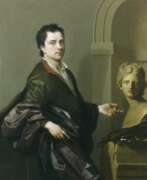

Michael Dahl was a Swedish portrait painter.
After several years of traveling in France and Italy, he finally settled in London in 1689, where he worked in the studio of Sir Godfrey Kneller. Dahl painted portraits of many aristocrats and some members of royal families. Michael Dahl soon became his teacher's chief rival and gained the patronage of Prince George of Denmark and his wife Princess Anne, whose portraits he also created. His studio practice flourished and he was the most popular portrait painter in London at the time.


Cesare Dandini was an Italian painter of the Baroque period, active mainly in his native city of Florence. He was the older brother of the painter Vincenzo Dandini. He enrolled in 1621 in the Accademia del Disegno. His style has the polish and attention to draughtsmanship and design characteristic of Florentines like Carlo Dolci.


Jan de Baen was a Dutch portrait painter who lived during the Dutch Golden Age. He was a pupil of the painter Jacob Adriaensz Backer in Amsterdam from 1645 to 1648. He worked for Charles II of England in his Dutch exile, and from 1660 until his death he lived and worked in The Hague. His portraits were popular in his day, and he painted the most distinguished people of his time.


Giovanni Andrea de Ferrari was an Italian painter of the Baroque period, active mainly in Genoa. A prolific easel painter who created many altarpieces, he was one of the chief influences on the later development of the Baroque in Genoa. Giovanni Andrea de Ferrari's subject matter was almost exclusively religious. He was such a close follower of the style of his master Strozzi that some of his pictures have been confused with those of his master. His style distinguishes itself, however, from his master's style through his thinner application of paint and his penchant for expressive van Dyckian heads, tapered hands and tightly rolled drapery sleeves. His paintings also reveal an interest in still-life painting and objects of everyday life, which are expressed with a great spontaneity.
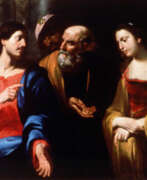

Orazio de Ferrari was an Italian artist, active in the Baroque period, born in Voltri, a suburb of Genoa. De Ferrari was a pupil of Giovanni Andrea Ansaldo. He was a member of the family of Genoese artists, with surnames de Ferrari, which also included Giovanni Andrea de Ferrari and Gregorio De Ferrari. During the 17th century, he painted murals in the chapel and many of the state rooms of the Royal Palace in Monaco.


Aert de Gelder was a Dutch painter. He was the only Dutch artist to paint in the tradition of Rembrandt's late style into the 18th century.
As author of biblical scenes and portraits his style was inspired by Rembrandt's, using his artistic ideas, well into the 18th century, without being influenced by contemporary new fashions. From the artistic point of view his work can not be considered as passive imitation of the master; indeed, it stands for inventiveness in the narrative, taste for the theatrical and a strong emotional charge of the characters. All these traits made him one of the most important interpreters of Dutch painting of the late seventeenth century.


Thomas Hendricksz de Keyser was a Dutch portrait painter, a dealer in Belgium bluestone and stone mason. He was the most in-demand portrait painter in the Netherlands until the 1630s, when Rembrandt van Rijn eclipsed him in popularity. Rembrandt was influenced by his work, and many of de Keyser's paintings were later falsely attributed to Rembrandt.


Jean-François de Troy was a French Rococo easel and fresco painter, draughtsman and tapestry designer. One of France's leading history painters in his time, he was equally successful with his decorative paintings, genre scenes and portraits. He was the inventor of the tableaux de modes ('paintings of fashions'), which attempted to provide a spirited portrayal of contemporary fashions, pastimes and manners.
He was the Director of the French Academy in Rome from 1738.


Marten de Vos (or Maarten de Vos, or Maerten de Vos) was a Dutch painter, draughtsman and graphic artist, dean of the Antwerp Guild.
After studying in Rome and Venice, de Vos returned to his native Antwerp in 1558 and became one of the city's leading artists. He created altarpiece images for many of Antwerp's churches. Many of his religious and historical paintings were later engraved, making him known throughout Flanders.
De Vos was also the founder of the Society of Romanists, whose members were famous artists and humanists of the time who appreciated the humanistic culture of Rome.


Francesco Cairo, also known as Francesco del Cairo, was an Italian Baroque painter active in Lombardy and Piedmont. It is not known where he obtained his early training though he is strongly influenced by the circle of il Morazzone, in works such as the Saint Teresa altarpiece in the Certosa di Pavia. Many of his works are eccentric depictions of religious ecstasies; the saints appear liquefied and contorted by piety. He often caps them with exuberant, oriental turbans.


Rutilio di Lorenzo Manetti was an Italian painter of late-Mannerism or proto-Baroque, active mainly in Siena. He was influenced and/or taught by the local artists Francesco Vanni and Ventura Salimbeni. His style moved from one derived from Barocci to a more Caravaggesque manner after the first decade of the 17th century. Among his masterpieces are his contributions to the Casino Mediceo, which he worked alongside Matteo Rosselli, Giovanni Lanfranco, and Cesare Dandini. One of his pupils or followers is Stefano Volpi.


Santi di Tito was one of the most influential and leading Italian painters of the proto-Baroque style – what is sometimes referred to as "Counter-Maniera" or Counter-Mannerism. Santi completely rejected the maniera of Bronzino, and embraced a classical Reformist and naturalistic style. Santi's mature style is reflected in his masterpiece of the Vision of Saint Thomas Aquinas, also known as Saint Thomas Dedicating His Works to Christ located in the church of San Marco in Florence.


Tiberio di Tito was an Italian painter. He was the son and pupil of the late-Mannerist painter Santi di Tito. He specialized in portrait painting, including small pencil portraits, on which he was much employed by Cardinal Leopoldo de' Medici.


Abraham Diepraam was a Dutch painter of the Golden Age and a member of the Guild of St. Luke in Dordrecht. He is known for his small genre works depicting interior tavern scenes with drinking or smoking peasants. He also painted portraits of ordinary people.


Giovanni Battista Discepoli also called "Lo Zoppo di Lugano" from his being a cripple, was a Swiss-Italian painter of the Baroque period, active mainly in Milan. He was a pupil of the painter Camillo Procaccini. In Milan, he painted a Purgatory for the church of San Carlo, and an Adoration of the Magi originally painted for San Marcello is now in the Brera Gallery. Lugano also has some of his works; in the church of Santa Teresa at Como is a picture of that Saint. One of his pupils was Pompeo Ghiti from Brescia.


Karel Dujardin was a Dutch painter and printmaker of the Golden Age of Dutch painting.
He studied with Klaas Berchem and Paulus Potter, traveled to Italy, and lived in Lyon. In 1656 he participated in the founding of the Pictura Society in The Hague.
Dujardin painted mostly Italian landscapes, genre scenes, including scenes from rural life, portraits of elegant people and historical paintings.
Many of Dujardin's works are in the Louvre, the Hermitage (St. Petersburg), as well as in Amsterdam, The Hague, Kassel, and Berlin.


Heyman Dullaert was a Dutch painter and poet of the Golden Age. He was a student of Rembrandt, but was better known for his poetry than for his works of art. His paintings, often trompe-l'œils, can be seen at the Kröller-Müller Museum.


Odoardo Fialetti was an Italian painter and printmaker who began his training during the late Renaissance, and showed distinct mannerist sensibilities in his mid-career, adopting a much looser and more dynamic style in his later life.
Born in Bologna, he initially apprenticed with Giovanni Battista Cremonini, and after traveling to Rome, he moved to Venice to work in the elderly Tintoretto's studio.
From 1604 to 1612, he is listed as member of the Venetian Fraglia dei Pittori. In Venice, he painted a St Agnes for the church of San Nicolò da Tolentino and scenes from the Life of St Dominic for the sacristy of the Santi Giovanni e Paolo.


Sebastiano Folli was an Italian painter of the late Renaissance period. He was a scholar of Alessandro Casolano, and a native of Siena. He distinguished himself by several frescoes in the churches at Siena, particularly the cupola of Santa Marta, and some subjects from the Life of St. Sebastian, in the church of that saint, painted in competition with Rutilio Manetti.


Lavinia Fontana was a Bolognese Mannerist painter active in Bologna and Rome. She is best known for her successful portraiture, but also worked in the genres of mythology and religious painting. She was trained by her father Prospero Fontana who was a teacher at the School of Bologna. She is regarded as the first female career artist in Western Europe as she relied on commissions for her income. Her family relied on her career as a painter, and her husband served as her agent and raised their 11 children. She was perhaps the first woman artist to paint female nudes, but this is a topic of controversy among art historians.


Baldassare Franceschini, called Il Volterrano after his birth place Volterra and, to distinguish him from Ricciarelli, Il Volterrano Giuniore was an Italian late Baroque painter and draughtsman active principally around Florence and Volterra. He was mainly known for his frescoes, altarpieces and easel paintings for churches and palaces in Florence, Volterra and Rome. His subject matter was diverse and included portraits, biblical and mythological scenes, history paintings and allegorical compositions.


Antonio Franchi was an Italian painter of the 17th century, active mainly in Florence and Lucca. In 1683 he was admitted to the Accademia dell'Arte del Disegno. He died in Florence. His paintings have the porcelain crispness of design, characteristic of Carlo Dolci; and some the sensuality of a Francesco Furini.


Johann Jakob Frey the Elder was a Swiss engraver.
After learning the principles of design he went, when he was twenty-two years of age, to Rome, where he received some instruction from Arnold van Westerhout, and had afterwards the advantage of studying in the school of Carlo Maratti. His progress was rapid, and he was soon regarded as one of the ablest artists in Rome.
His drawing is correct and tasteful, and he was a perfect master of harmony and effeot. He etched his plates with spirit, and worked over the etching with a firm and masterly hand. His prints, which exceed the number of one hundred, are generally of a very large size.


Ippolito Galantini was an Italian Baroque painter and religious figure. Known by the nicknames Il Capuccino and Il Prete Genovese.
Born in Florence, he was for a time a pupil of Stefaneschi, under whose influence he became a monk of the Capuchin order (hence the two nicknames by which he is known). He was sent as a missionary to India, where he spent several years, and on his return to Europe painted several paintings for the churches of his order. There is a self-portrait of him in the Uffizi Gallery in Florence.


Frans Geffels, known in Italy as Francesco Geffels (25 August 1624 – 18 February 1694) was a Flemish painter, printmaker, architect, stage designer and designer of ephemeral structures for solemn and festive occasions. After training in his native Antwerp, he was mainly active in Mantua, where he was prefetto delle fabbriche to the Duke, a role that gave him the direction of the artistic and construction activities undertaken by the Ducal court. He worked also on projects for the local aristocratic class of Mantua. In addition, he completed projects for the Liechtenstein princes and for the imperial court in Vienna.
He was both a canvas and fresco painter. He created portraits, history subjects, military scenes, architectural scenes and genre art, in particular merry companies. Geffels is mainly remembered as the designer of some of the key examples of Baroque architecture in Mantua.


Orazio Gentileschi, an Italian painter born in 1563 in Pisa, is celebrated for his contributions to the Baroque style, particularly after adopting Caravaggio's revolutionary approach. Initially, Gentileschi worked in a Mannerist style but evolved his technique to incorporate Caravaggio's focus on naturalism and dramatic lighting, which significantly influenced his later works.
Orazio Gentileschi's career took him across Italy and eventually to the courts of Paris and London, where he served under Queen Henrietta Maria of England. This period is marked by an elegant and refined style, distinct from his earlier, more naturalistic works. Notable paintings from his English period include "The Finding of Moses" and various ceiling paintings at the Queen's House in Greenwich.
Orazio's influence extended beyond his own artworks; he was part of a family of artists, with his daughter Artemisia Gentileschi also achieving prominence as a Baroque painter. His works continue to be appreciated for their compositional skill and the delicate interplay of light and shadow, reflecting the Baroque era's dramatic intensity and emotional depth.
For those interested in the rich tapestry of Baroque art, Gentileschi's oeuvre offers a fascinating study in the evolution of style from Mannerism to the heightened expressiveness of Caravaggio's naturalism. If you're keen on delving deeper into Orazio Gentileschi's art and legacy, consider subscribing for updates on exhibitions, sales, and scholarly insights into his work and its historical context.


Marcus Gerards the Younger was a Flemish portrait painter of the Renaissance.
Marcus Gerards the Younger was considered one of the most talented portraitists of Britain at the end of the XVI century, was under the patronage of Princess Anne of Denmark (1574-1619), wife of King James I Stuart of England and Scotland. In 1610 he became a court painter, whose work was highly paid. He painted portraits of King James I, Queen Anne and their children.




Frans Hals was a Dutch painter who painted during the so-called Golden Age. He is considered to be one of the most important old Dutch masters. As far as is known, Frans Hals worked all his life in Haarlem and became best known for his lively and colourful paintings of his contemporaries.


Daniël Haringh was an 18th-century painter from the Northern Netherlands. He was a pupil during the years 1664–1669 of Arnold van Ravesteyn and Caspar Netscher, and in 1669 he became a member of the Confrerie Pictura. He is known for portraits and interior decorations. His pupils were Richard van Bleeck, Michiel Godijn, Abraham van Hoogstraten, and Dirk Kindt, or Kint.


Wenceslaus Hollar, born on July 13, 1607, in Prague, was a Bohemian artist acclaimed for his etchings and engravings. His journey in art began in Germany, where he studied under the engraver Matthäus Merian. Hollar's career flourished when he moved to England, where he worked for various print sellers and publishers, including the notable John Ogilby and antiquarian Sir William Dugdale.
Hollar is remembered for his intricate and detailed works that include over 2,000 pieces, ranging from classical and historical subjects to portraits, costumes, and topographical scenes. His skill in translating texture into the etched medium was unparalleled, even as he lost most of the sight in one eye. Some of his most significant works include "Views of London," created after the Great Fire of London in 1666, which became valuable historical records of the city.
Tragically, Hollar's life was marked by hardships, including financial struggles and the loss of his young son to the plague. Despite these challenges, his dedication to his craft never waned. He continued to produce high-quality works until his death on March 25, 1677, in extreme poverty. Today, his works are held in high regard and are preserved in prestigious collections such as the British Museum in London and the National Gallery in Prague.
Hollar's legacy is a testament to his exceptional talent and his ability to capture the essence of his subjects with precision and depth. His works continue to be a rich source of historical and artistic knowledge, particularly for collectors, auctioneers, and experts in art and antiques.
For those interested in the remarkable etchings and engravings of Wenceslaus Hollar, staying informed about exhibitions and sales of his work can offer valuable insights into his unique artistic perspective.




Hendrik Hondius I was a Flemish-born and trained engraver, cartographer, and publisher who settled in the Dutch Republic in 1597. Hondius was apprenticed in Brussels to Godfried van Ghelder, goldsmith to Alexander Farnese, Duke of Parma. He also studied drawing with the engraver Jan Wierix of Antwerp. At this time he started to study engraving. He applied himself to mathematics and studied perspective, architecture and the construction of fortifications. He moved to The Hague by 1597. He obtained his first print privilege for a portrait of Prince Maurits. He dedicated himself to his engraving practice. His work was very well received and he got commissions from many eminent personalities for engravings or drawings. He turned more to publishing rather than engraving and printing in the 1630s. His publications were mainly maps, books about fortifications and official portraits.[5] He also reused original plates and blocks by earlier artists for reprinting and such reprints represented almost a third of his publishing output. In the 1640s he returned to printing concentrating exclusively on etching. One of the most important publications of Hondius was the work Pictorum aliquot celebrium praecipue Germaniae inferioris Effigies (Effigies of some celebrated painters, chiefly of Lower Germany) of 1610, which was a collection of 69 portraits of mainly Netherlandish artists.


Cornelis Jansens van Keulen or Cornelius Johnson was an English painter of portraits of Dutch or Flemish parentage. He was active in England, from at least 1618 to 1643, when he moved to Middelburg in the Netherlands to escape the English Civil War. Between 1646 and 1652 he lived in Amsterdam, before settling in Utrecht, where he died.


Sir Godfrey Kneller, 1st Baronet (born Gottfried Kniller) was a late seventeenth- and early eighteenth-century German painter and the leading British portrait painter of his era.
Gottfried Kniller was an immensely popular painter among the English nobility, and over the course of his career he produced hundreds of paintings depicting influential European nobles and royalty. His unique masterpieces are preserved in many museums across Europe, and his biography is an example of the successful career of a great master.


